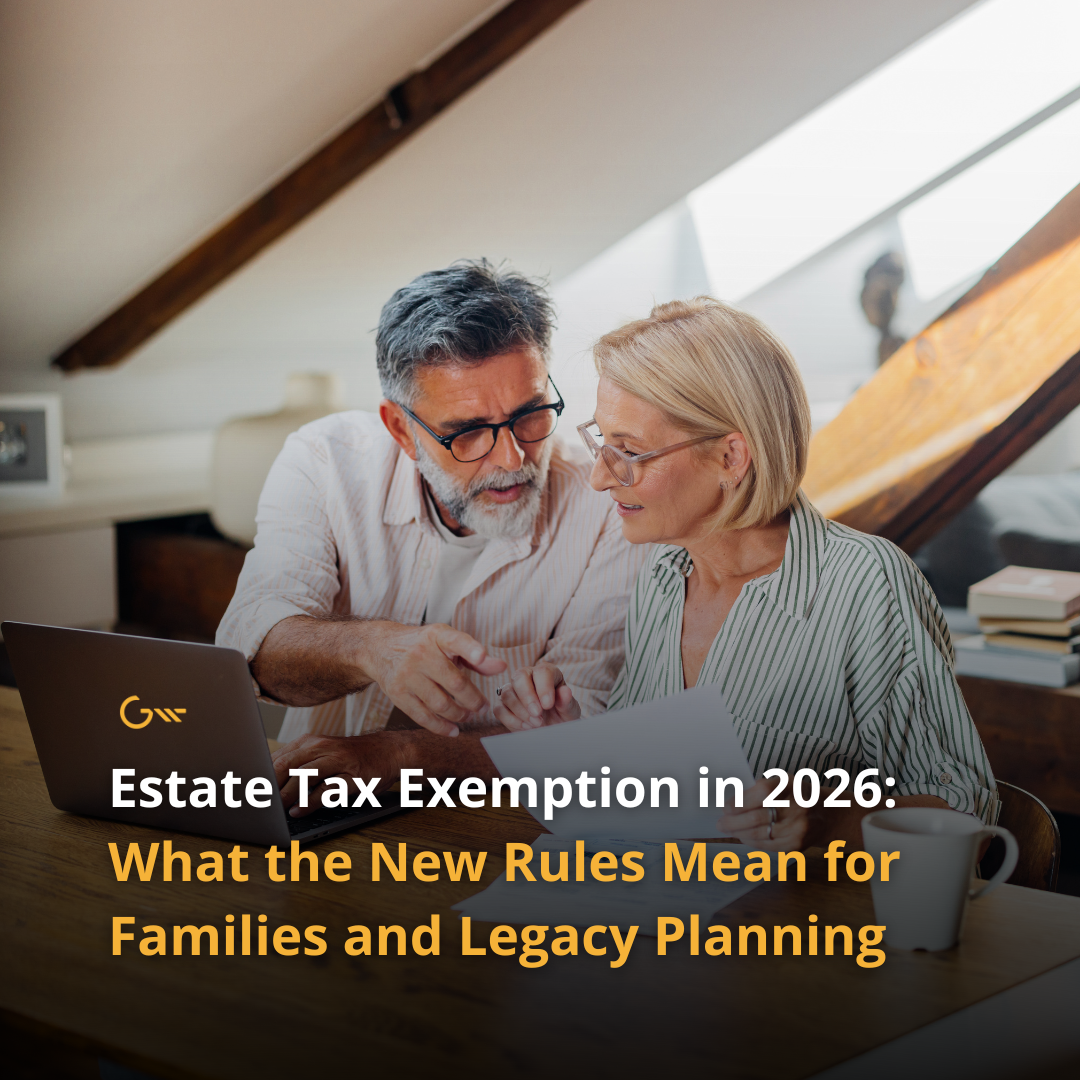Introduction
When Congress passed the Tax Cuts and Jobs Act (TCJA) of 2017, one of the most significant changes for families with substantial assets was the temporary doubling of the estate tax exemption. This created unprecedented flexibility for wealth transfer.
For 2025, the estate tax exemption is set at $13.99 million per individual or $27.98 million per married couple, adjusted for inflation. Beginning in 2026, that exemption will change again — a shift that affects families at many different stages of their financial journey.
Understanding how these changes impact you, your family, and your charitable goals is essential to making thoughtful, proactive decisions.
What Is the Estate Tax Exemption?
An estate tax exemption is the amount of wealth you can transfer at death before federal estate taxes apply. Anything above the exemption may be subject to estate tax.
For example:
- In 2025, if your estate is valued at $15.99 million, only the $2 million above the $13.99 million exemption is subject to estate tax.
- The tax does not apply to the entire estate, only the amount above the exemption.
This distinction matters. It allows families to make strategic choices about wealth transfer, minimizing tax exposure while aligning with their legacy goals.
Looking Back: The Temporary TCJA Expansion
The 2017 legislation temporarily doubled the exemption, creating an opportunity for families to pass on more wealth without incurring estate tax.
- Before 2017: Lower exemption (roughly $5.5 million per individual).
- 2017–2025: Doubled exemption, adjusted for inflation, reaching today’s $13.99 million.
- Concern: The law was set to “sunset” after 2025, potentially cutting the exemption in half.
This uncertainty led many families to consider gifting strategies, irrevocable trusts, and charitable giving to take advantage of the higher exemption before it potentially expired.
2026 and Beyond: What Has Changed
At the start of this year, there was speculation: would Congress make the higher exemption permanent, or let it revert?
We now have clarity:
- In 2026, the exemption will be $15 million per individual, $30 million per married couple.
- The exemption will continue to be adjusted for inflation in future years.
This permanence was established through the One Big Beautiful Bill Act (OBBBA), which removed the sunset provision from the 2017 legislation and locked in the higher exemption levels.
This is a meaningful shift. For families, it represents not just an opportunity, but also a renewed call to revisit financial plans and estate strategies.
Practical Planning Opportunities
Whether your estate is near the exemption threshold or well below it, planning today can help position your wealth for future generations.
1. Strategic Gifting
- Gifting assets to children, grandchildren, or charities before death allows you to reduce the size of your taxable estate.
- You can make use of the annual gift tax exclusion (currently $19,000 per recipient in 2025).
- Larger lifetime gifts can also be made, using up part of your exemption during life.
2. Trusts as Planning Tools
- Irrevocable trusts can lock in today’s higher exemption and transfer assets outside your taxable estate.
- Spousal Lifetime Access Trusts (SLATs) allow one spouse to benefit while still removing assets from the estate.
- Charitable remainder trusts can balance tax efficiency with philanthropic goals.
3. Married Couples and Portability
- Married couples can effectively double their exemption by combining planning techniques.
- The portability provision allows a surviving spouse to use the unused portion of a deceased spouse’s exemption.
4. Charitable Giving
- Gifts to qualified charities are fully deductible for estate tax purposes.
- Including charities in your estate plan may allow you to further reduce taxable wealth while supporting causes that matter to you.
A Real-World Example
Consider a business owner with an estate valued at $25 million in 2025.
- Under the 2025 exemption, about $11 million would be subject to estate tax.
- Starting in 2026, with the exemption rising to $15 million, only $10 million would be taxable.
That $1 million difference in taxable estate could mean hundreds of thousands of dollars saved in estate tax liability, simply due to the timing of legislation.
Why Planning Still Matters
While the higher exemption provides flexibility, estate planning is about much more than tax efficiency. It’s about ensuring that your wealth is used in ways that reflect your values, your family’s needs, and your legacy goals.
At Gatewood, we often remind families:
- Estate planning is not just for the wealthy. Even if your estate is below the exemption, planning ensures clarity around healthcare, guardianship, and wealth transfer.
- Tax law can shift again in the future. A thoughtful plan provides adaptability.
- Legacy decisions are deeply personal — tax strategy is just one part of a bigger picture.
Next Steps for Families
If you haven’t reviewed your estate plan recently, now is the time. Key steps include:
- Reviewing your current estate plan with your advisory team.
- Considering whether trusts, gifting, or charitable strategies align with your goals.
- Coordinating with estate planning attorneys to ensure legal documents match your intentions.
- Updating beneficiaries on retirement accounts, insurance, and other assets.
Conclusion
The 2026 estate tax exemption update offers an expanded opportunity to transfer wealth on your terms. Whether you are focused on retirement readiness, business succession, or family legacy, planning today can help you pursue your goals with clarity.
At Gatewood, our advisors work closely with clients and their attorneys to design strategies tailored to life stage and family priorities.
Schedule a conversation with our team today to explore how these changes may apply to your financial plan.
Important Disclosures
Securities and advisory services are offered through LPL Financial (LPL), a registered investment advisor and broker-dealer (member FINRA/SIPC).
The opinions voiced in this material are for general information only and are not intended to provide specific advice or recommendations for any individual.
Investing involves risk including loss of principal. No strategy assures success or protects against loss.
The economic forecasts set forth in this material may not develop as predicted and there can be no guarantee that strategies promoted will be successful.
This information is not intended to be a substitute for specific individualized tax or legal advice. We suggest that you discuss your specific situation with a qualified tax or legal advisor.






